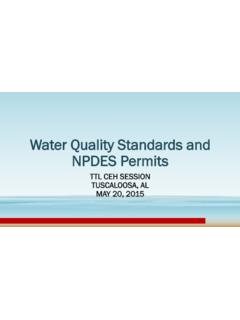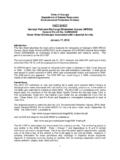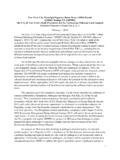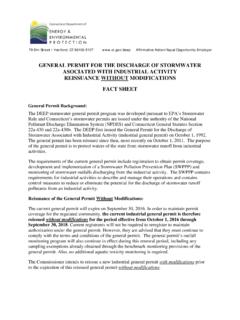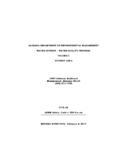Transcription of CHAPTER 4. NPDES Permit Application Process - …
1 September 2010 NPDES Permit Writers Manual CHAPTER 4: NPDES Permit Application Process 4-1 CHAPTER 4. NPDES Permit Application Process This CHAPTER describes the National Pollutant Discharge Elimination System ( NPDES ) Permit Application Process , including the Permit writer s role in reviewing the Application and evaluating background information about the applicant. Through this Process the Permit writer gains an understanding of the circumstances of the discharge and the characteristics of the proposed effluent, which is necessary to develop appropriate Permit limitations and conditions. Who Applies for an NPDES Permit ? The NPDES regulations at Title 40 of the Code of Federal Regulations (CFR) (a) require that any person, except persons covered by general permits under , who discharges pollutants or proposes to discharge pollutants to waters of the United States must apply for a Permit .
2 Further, (e) prohibits the permitting authority from issuing an individual Permit until and unless a prospective discharger provided a complete Application . This regulation is broadly inclusive and ties back to the Clean Water Act (CWA) section 301(a) provision that, except as in compliance with the act, ..the discharge of any pollutant by any person shall be unlawful. In most instances, the Permit applicant will be the owner ( , corporate officer) of the facility. However, the regulations at (b) require that when a facility or activity is owned by one person but is operated by another person, it is the operator s duty to obtain a Permit . The regulations also require the Application to be signed and certified by a high-ranking official of the business or activity. The signatory and certification requirements are at Permits (and applications ) are required for most discharges or proposed discharges to waters of the United States; however, NPDES permits are not required for some activities as specified under the Exclusions provision in Exceptions include the following: Discharge of dredged or fill materials into waters of the United States which are regulated under CWA section 404.
3 The introduction of sewage, industrial wastes or other pollutants into publicly owned treatment works (POTWs) by indirect dischargers. Any discharge in compliance with the instructions of an On-Scene Coordinator pursuant to Part 300 (The National Oil and Hazardous Substances Pollution Contingency Plan) or 33 CFR (e) (Pollution by Oil and Hazardous Substances). Any introduction of pollutants from nonpoint source agricultural and silvicultural activities, including stormwater runoff from orchards, cultivated crops, pastures, range lands, and forest lands, but not discharges from concentrated animal feeding operations as defined in , discharges from concentrated aquatic animal production facilities as defined in , discharges to aquaculture projects as defined in , and discharges from silvicultural point sources as defined in Return flows from irrigated agriculture.
4 September 2010 NPDES Permit Writers Manual 4-2 CHAPTER 4: NPDES Permit Application Process Discharges into a privately owned treatment works, except as the Director may otherwise require under (m). While those types of discharges have been excluded from permitting requirements under the NPDES program, they might be subject to controls under other federal or state regulatory programs. As of the date of this manual s publication, the exclusion for certain discharges incidental to the normal operation of a vessel is still in the CFR. Similarly, discharges from the Application of pesticides consistent with all relevant requirements under the Federal Insecticide, Fungicide and Rodenticide Act (FIFRA) ( , those relevant to protecting water quality) are excluded from NPDES Permit coverage in the following two circumstances: (1) the Application of pesticides directly to waters of the United States to control pests, and (2) the Application of pesticides to control pests that are present over waters of the United States, including near such waters, where a portion of the pesticides will unavoidably be deposited to waters of the United States to target the pests effectively.
5 However, because of court decisions, the exclusions for vessels and pesticides are vacated as of February 6, 2009, and April 9, 2011, respectively. The effect of the vacaturs on the exclusions in is presented in Exhibit 4-1. Exhibit 4-1 Effect of court decisions on Exclusion Issue Vessel Discharges ( ) The Court s ruling does not affect vessel discharge exemptions from permitting that are specifically provided for in the CWA itself. For example, 502(6)(A) excludes from the act s definition of pollutant sewage from vessels (including graywater in the case of commercial vessels operating on the Great Lakes) and discharges incidental to the normal operation of a vessel of the Armed Forces within the meaning of CWA section 312. As another example, the CWA section 502(12)(B) provides that discharges from vessels ( , discharges other than those when the vessel is operating in a capacity other than as a means of transportation) do not constitute the, discharge of a pollutant when such discharges occur beyond the limit of the 3-mile territorial sea.
6 Because both a pollutant and a discharge of a pollutant are prerequisites to the requirement to obtain an NPDES Permit , those two statutory provisions have the effect of exempting the vessel discharges they address from the requirement to obtain an NPDES Permit . In addition, in July 2008, Congress amended the CWA to add a new section 402(r) to the act, which excludes discharges incidental to the normal operation of a recreational vessel from NPDES permitting. For more information, see section of this manual. Pesticides ( ) On January 7, 2009, the 6th Circuit Court vacated the final rule in The National Cotton Council of America et al. v. United States Environmental Protection Agency. The court held that while an NPDES Permit is not required for chemical pesticide applications that leave no residuals, an NPDES Permit is required for discharges (1) from chemical pesticide applications to or over, including near water, where there is a residual, or excess pesticide, in the water following the Application , and (2) from all biological pesticide applications regardless of whether a residual is left.
7 On June 8, 2009, the court granted a request from the Department of Justice for a 2-year stay of its decision, until April 9, 2011, to provide time for EPA and the states to develop and issue NPDES general permits for the discharge of pollutants from the Application of pesticides. Before April 9, 2011, permits are not required for discharges from these applications when applied in accordance with the product s FIFRA label. Certain related activities continue to be exempt from permitting under the CWA ( , irrigation return flow and agricultural stormwater runoff). September 2010 NPDES Permit Writers Manual CHAPTER 4: NPDES Permit Application Process 4-3 Application Deadlines The regulations at (c) and (d) specify the time to apply for NPDES permits. Exhibit 4-2 summarizes the Application deadline requirements for dischargers to be covered by an NPDES Permit .
8 Exhibit 4-2 When to apply for an NPDES Permit Type of Permit Type of discharge Schedule* New At least 180 days before the date on which the discharge is to commence Existing At least 180 days before expiration date of existing Permit Individual Construction StormwaterAt least 90 days before the date on which construction is to commence New Specified in general Permit General Existing X number of days following issuance of Permit (specified in the general Permit ) * Authorized states may use more stringent deadlines. Anyone proposing a new discharge must apply to the permitting authority no later than 180 days before the expected commencement of the discharge if applying for an individual Permit . Any person with an currently effective individual Permit must submit an Application to the permitting authority at least 180 days before the expiration of its existing individual Permit unless permission for a later date has been granted in accordance with (d).
9 For general permits, the deadline for new dischargers to apply is specified in the general Permit . A general Permit also may specify a number of days after the general Permit s issuance that operators of existing facilities are given to apply for coverage. Authorized states may have different schedules for Permit applications , but their schedules may be no less stringent than the federal deadlines. The State Director or the Regional Administrator may allow an individual Application to be submitted at dates later than those specified in the regulations, but not later than the expiration date of the existing Permit . Note that, according to , the conditions of an expired NPDES Permit remain in effect until the new Permit is issued, as long as the discharger submitted a complete Application in accordance with the timeframes prescribed in the regulations (or in accordance with state law, in the case of state-administered NPDES programs).
10 If state law does not allow expired permits to remain in effect until a Permit is reissued, or if the Permit Application is not on time and complete, the facility may be considered to be discharging without a Permit from the time the Permit expired until the effective date of the new Permit . Application Forms and Requirements for Individual Permits When a facility needs an individual NPDES Permit , it must submit a Permit Application . Application forms and requirements are specific to the type of facility and discharge. NPDES Permit Application requirements are in Part 122, Subpart B and identified on forms developed by the Environmental Protection Agency (EPA). Authorized states are not required to use the EPA Application forms; however, any alternative form used by an authorized state must include the federal requirements at a minimum.










